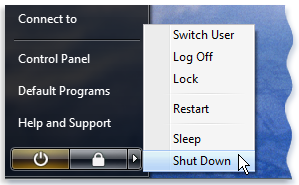Turning off your computer properly
When you’re done using your computer, it’s important to turn it off properly—not only to save energy, but also to ensure that your data is saved and to help keep your computer more secure. Best of all, your computer will start quickly the next time you use it.
Use the Power button on the Start menu
 , and then click the Power button in the lower right corner of the Start menu. The Power button normally looks like this:
, and then click the Power button in the lower right corner of the Start menu. The Power button normally looks like this:When you click this button, your computer goes to sleep. Windows automatically saves your work, the display turns off, and any noise from the computer’s fan stops. Usually, a light on the outside of your computer case blinks or turns yellow to indicate that the computer is sleeping. The whole process takes only a few seconds.
Because Windows saves your work, there’s no need to close your programs and files before putting your computer to sleep. The next time you turn on your computer (and enter your password, if required), the screen will look exactly as it did when you turned off your computer.
To wake your computer, press the power button on your computer case. Because you don’t have to wait for Windows to start, your computer wakes within seconds and you can resume work almost immediately.
Note
- While your computer is sleeping, it uses a very small amount of power to maintain your work in its memory. If you’re using a mobile PC, don’t worry— the battery won’t be drained. After the computer has been sleeping for several hours, or if the battery is running low, your work is saved to the hard disk, and then your computer turns off completely, drawing no power.
Why your Power button might look different
The Start menu’s Power button can change its appearance. Under some circumstances, the button looks like this:
When you click the button in this form, your computer shuts down. Unlike putting your computer to sleep, shutting down closes all open programs, along with Windows itself, and then turns off your display and computer completely. Because shutting down doesn’t save your work, you must save your files before shutting down.
The Power button shuts down your computer under the following circumstances:
- The Sleep option is not available on your computer hardware.
- You or your computer administrator has set the Power button to always shut down the computer. (The settings can be changed by following the instructions below.)
To change the Power button settings
-
Open Power Options by clicking the Start button
 , clicking Control Panel, clicking System and Maintenance, and then clicking Power Options.
, clicking Control Panel, clicking System and Maintenance, and then clicking Power Options.
- Under the currently selected power plan, click Change plan settings.
- In the Edit Plan Settings dialog box, click Change advanced power settings.
- In the Power Options dialog box, click the plus sign (+) next to Power buttons and lid to expand the list.
- Click the plus sign (+) next to Start menu power button to expand the list.
- On a desktop computer, in the Setting list, click a setting for the Power button. – or – On a mobile PC, in the On battery and Plugged in lists, click settings for the Power button.
- Click OK. If you are connected to a network domain, it’s possible that settings made by your network administrator (Group Policy settings) will prevent you from completing the steps above.
-
Open Power Options by clicking the Start button
There’s one other form that the Power button can take. If you’ve set your computer to receive updates automatically, and the updates are ready to be installed, the button appears with a shield on it:
When you click the button in this form, Windows installs the updates and then shuts down your computer when installation is complete.
Note
- Starting your computer after it has been shut down takes longer than waking your computer from sleep—typically 30 seconds or more, depending on the speed of your computer.
When to shut down
Even though putting your computer to sleep is the fastest way to turn it off, and the best option for resuming work quickly, there are certain times when you should shut down instead:
- You are adding or upgrading the hardware inside your computer—such as installing memory, a disk drive, a sound card, or a video card. Shut down the computer, and then disconnect it from its power source before proceeding with the upgrade.
- You are adding a printer, monitor, external drive, or other hardware device that does not connect to a universal serial bus (USB) or IEEE 1394 port on your computer. Shut down the computer before connecting the device.
To shut down your computer, click the arrow next to the Lock button, and then choose Shut Down.
Mobile PC users: Close the lid
If you have a mobile PC, there’s an even easier way to turn off your computer: Close the lid. You can choose whether your computer sleeps, shuts down, or enters another power-saving state. See Change what happens when you close your mobile PC lid.
If you prefer, you can turn off your mobile PC by pressing the power button on its case. See Change the function of the Power button on a mobile PC.






